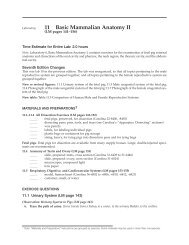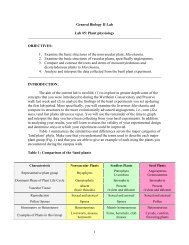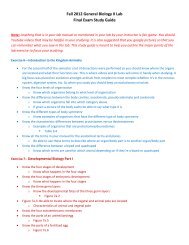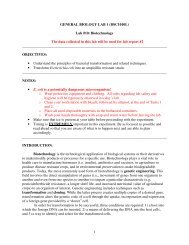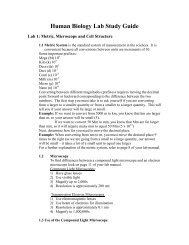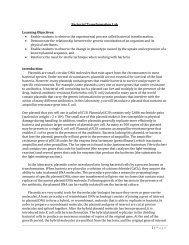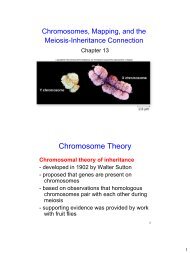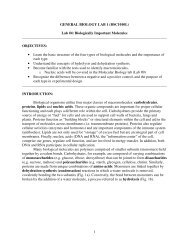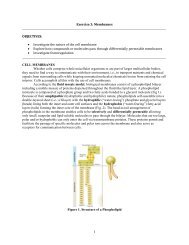Plant Physiology
Plant Physiology
Plant Physiology
Create successful ePaper yourself
Turn your PDF publications into a flip-book with our unique Google optimized e-Paper software.
General Biology II LabLab #5: <strong>Plant</strong> physiology________________________________________________________________________OBJECTIVES:1. Examine the basic structures of the nonvascular plant, Marchantia.2. Examine the basic structures of vascular plants, specifically angiosperms.3. Compare and contrast the roots and stems of monocotyledonous anddicotyledonous plants to Marchantia.4. Analyze and interpret the data collected from the basil plant experiment.________________________________________________________________________Read pages 63-68 in your lab manualQuestions:1. Describe the types of habitats that Marchantia and other bryophytes were locatedin during the campus walk?2. Compare the overall size of bryophytes to other gymnosperms and angiosperms inthe FIU Preserve ecosystem. Give specific examples.Procedure: Examine Marchantia1. Examine the following structures under a dissecting microscopea. antheridiab. archegoniac. gemmae cups2. Sketch what you observe in the spaces provided below.1
Gemmae cupsMagnification: ______ArchegoniaMagnification: ______AntheridiaMagnification: _______Questions:1. Describe the general location of the antheridium and archegonium on the liveMarchantia and explain how location of these organs relates to their reproductivefunction?2. Are spores produced by the sporophyte diploid or haploid?a. What about gemmae, are they diploid or haploid?________________________________________________________________________Task 2: Compare the root systems of monocotyledonous and dicotyledonous plants2
Procedure 1: Examine fast plant and corn seedlings1. Last week you planted corn and fast plant seeds. Examine the developing rootsfrom each type of seedling and sketch your observations in the space provided.2. Identify the following structuresa. radicle (embryonic root)b. cotyledons (seed leaves; function in the absorption of nutrients from theseed until the plant can produce leaves for photosynthesis)c. seedBrassica rapaZea maysQuestions:1. What type of root system does Brassica rapa (Fast <strong>Plant</strong>) possess?a. What about Zea mays (Corn)?3. Based on the root systems present in each of the aforementioned organisms,which plant is a monocot and which is a dicot? Explain.4. What is the purpose of root hairs?3
a. Are root hairs present in both plants?===============================================================Procedure 2: Compare and contrast root and stems of monocots and dicotsIn addition to differences in root type, among other factors, monocots and dicotsalso vary in the arrangement of their vascular tissue, i.e. xylem, which transports waterand minerals, and phloem, which transports organic compounds. In dicot roots, phloemtissue lies between the arms of the xylem in the center of the root whereas in monocotroots, xylem and phloem form a ring. Vascular tissues in the stems of dicots lay in adistinct ring, as opposed to monocots, where the vascular bundles are scatteredthroughout.Procedure:1. Examine prepared slides of monocot and dicot roots and stems2. Identify the following structures:a. xylemb. phloemc. epidermisd. endodermis3. Note what you observe for each slide in the spaces provided below.Monocot RootMagnification: _____Dicot RootMagnification: _____Monocot StemMagnification: _____Dicot StemMagnification: _____4
Task 3: Review the different parts of a plant using your fast plantsNow that you have examined the roots and stems of angiosperms, we will shiftour focus to the remainder of the plant body. Structurally, angiosperms are composed offive main parts: (1) roots, (2) stems, (3) leaves, (4) flowers, and (5) fruits (Fig. 5.8).Recall from last week’s lab that leaves are either simple or compound and are arrangedon the stem in one of three orientations, i.e. alternate, opposite or whorled. Inangiosperms, the venation pattern of leaves (netted vs. parallel), as well as flowerarrangement, also differs between monocots and dicots. In addition, angiosperms differwith regard to the location of the male (stamen) and female (pistil) reproductivestructures; monoecious flowers possess pistils and stamens on different flowers but onthe same plant while dioecious flowers have male and female structures on two differentplants. Hermaphroditic plants are plants that contain flowers which have both male(stamen) and female (pistil) reproductive structures on the same flower as shown infigure 5.9. Reproduction in angiosperms is sexual and, in contrast to Marchantia,involves double fertilization whereby both a zygote and endosperm (nutritive tissuethat supports the developing embryo) are formed. As the embryo matures, it developsinto a seed and as it does, the ovary enlarges into a fruit. In general, fruits function toprotect the developing seed and also aid in their dispersal, i.e. their color, smell and tasteattract animals which eat them and then deposit the seeds at a considerable distance fromthe parent. Fruits are typically classified as either simple, complex or dry. Simple fruitsare further subdivided into drupes (cherry), berries (tomato) and pomes (apple),complex fruits into aggregate (raspberry) and multiple (pineapple) and dry fruits intolegumes (beans).Figure 5.8 Main parts of a plantFigure 5.9 Parts of a flower5
Procedure 3A:Using your group’s fast plants, identify the structures illustrated in Figure 5. Use Figures5.8 and 5.9 to guide you, but keep in mind that Brassica rapa might not possess everystructure shown in these figures.Questions:1. Describe the leaf structure and arrangement observed in your Brassica rapaplants.a. Are the leaves simple or compound?b. How are the veins arranged on the leaves?c. Describe the leaf arrangement on the stems.2. If you have pollinated your flowers and can see the developing fruit, what kind offruit does Brassica rapa produce?3. If present, how many petals do the Brassica rapa flowers have?4. Based on your observations, is Brassica rapa a monocot or a diocot? Explain yourreasoning.Procedure 3B:Obtain a flower for your group and locate all the different parts of the flower using figure5.9 and then answer the questions below.Questions:1. Are the leaves simple or compound?6
2. What type of leaf venation does it have?3. What type of leaf arrangement does it have?4. How many petals does the flower have?a. Are the petals in sets?5. Based on the information you collected above, is your flower a monocot or dicot?How can you tell?===============================================================Task 4: Data analyses of the Basil experimentFive weeks ago you and your lab mates designed an experiment to determine therole of macronutrients on the growth of basil. Since then, you have been tracking yourplants across different treatments and recording the data each week. At this point, it istime to analyze the results of your experiments and determine whether your data supportsor rejects your hypotheses. Before beginning this task, answer the questions below toreview your experimental design and variables.1. What were your null and alternate hypotheses?a. H o :b. H a :2. What were your independent variables?3. What were your dependent variables?7
4. Which treatment (s) served as your control?Note: For the next part of this exercise, you will need to have the class data setthat your TA will give you.Mean = sum of all samples / number of observations in a sampleVariance = [sum (measured value for each sample – mean) 2 ] / (sample size -1)= ∑ (x-x) 2N-1Standard Deviation = √variance5. Calculate the mean for the class data set.6. Calculate the variance for the class data set.7. Calculate the standard deviation for the class data set.8



